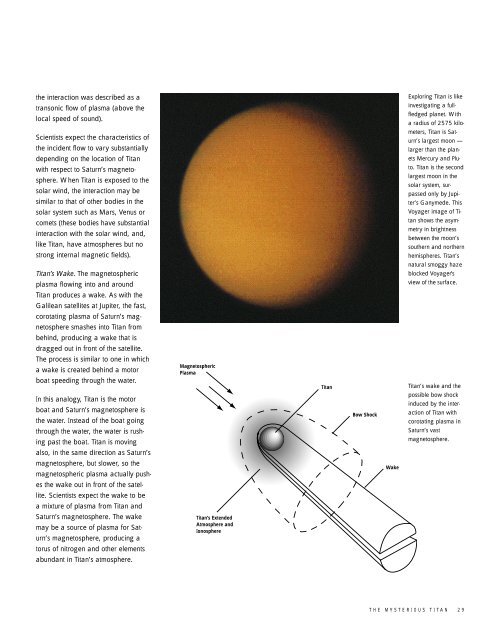Passage to a Ringed World - NASA's History Office
Passage to a Ringed World - NASA's History Office
Passage to a Ringed World - NASA's History Office
Create successful ePaper yourself
Turn your PDF publications into a flip-book with our unique Google optimized e-Paper software.
the interaction was described as a<br />
transonic flow of plasma (above the<br />
local speed of sound).<br />
Scientists expect the characteristics of<br />
the incident flow <strong>to</strong> vary substantially<br />
depending on the location of Titan<br />
with respect <strong>to</strong> Saturn’s magne<strong>to</strong>sphere.<br />
When Titan is exposed <strong>to</strong> the<br />
solar wind, the interaction may be<br />
similar <strong>to</strong> that of other bodies in the<br />
solar system such as Mars, Venus or<br />
comets (these bodies have substantial<br />
interaction with the solar wind, and,<br />
like Titan, have atmospheres but no<br />
strong internal magnetic fields).<br />
Titan’s Wake. The magne<strong>to</strong>spheric<br />
plasma flowing in<strong>to</strong> and around<br />
Titan produces a wake. As with the<br />
Galilean satellites at Jupiter, the fast,<br />
corotating plasma of Saturn’s magne<strong>to</strong>sphere<br />
smashes in<strong>to</strong> Titan from<br />
behind, producing a wake that is<br />
dragged out in front of the satellite.<br />
The process is similar <strong>to</strong> one in which<br />
a wake is created behind a mo<strong>to</strong>r<br />
boat speeding through the water.<br />
In this analogy, Titan is the mo<strong>to</strong>r<br />
boat and Saturn’s magne<strong>to</strong>sphere is<br />
the water. Instead of the boat going<br />
through the water, the water is rushing<br />
past the boat. Titan is moving<br />
also, in the same direction as Saturn’s<br />
magne<strong>to</strong>sphere, but slower, so the<br />
magne<strong>to</strong>spheric plasma actually pushes<br />
the wake out in front of the satellite.<br />
Scientists expect the wake <strong>to</strong> be<br />
a mixture of plasma from Titan and<br />
Saturn’s magne<strong>to</strong>sphere. The wake<br />
may be a source of plasma for Saturn’s<br />
magne<strong>to</strong>sphere, producing a<br />
<strong>to</strong>rus of nitrogen and other elements<br />
abundant in Titan’s atmosphere.<br />
Magne<strong>to</strong>spheric<br />
Plasma<br />
Titan’s Extended<br />
Atmosphere and<br />
Ionosphere<br />
Titan<br />
Bow Shock<br />
Wake<br />
Exploring Titan is like<br />
investigating a fullfledged<br />
planet. With<br />
a radius of 2575 kilometers,<br />
Titan is Saturn’s<br />
largest moon —<br />
larger than the planets<br />
Mercury and Plu<strong>to</strong>.<br />
Titan is the second<br />
largest moon in the<br />
solar system, surpassed<br />
only by Jupiter’s<br />
Ganymede. This<br />
Voyager image of Titan<br />
shows the asymmetry<br />
in brightness<br />
between the moon’s<br />
southern and northern<br />
hemispheres. Titan’s<br />
natural smoggy haze<br />
blocked Voyager’s<br />
view of the surface.<br />
Titan’s wake and the<br />
possible bow shock<br />
induced by the interaction<br />
of Titan with<br />
corotating plasma in<br />
Saturn’s vast<br />
magne<strong>to</strong>sphere.<br />
THE MYSTERIOUS TITAN 29
















